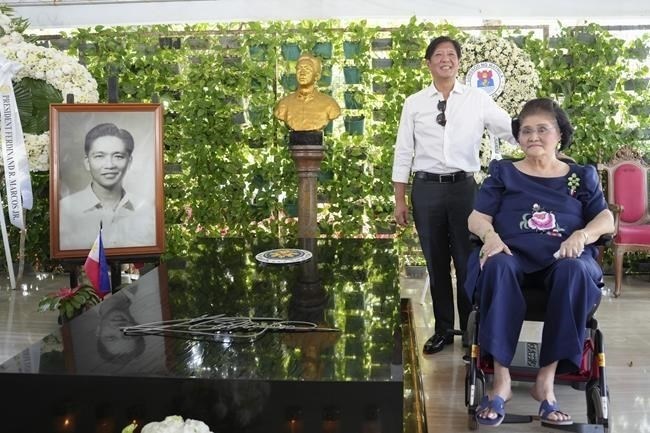
In this handout photo provided by the Malacanang Presidential Communications Office, Philippine President Ferdinand Marcos Jr., left, and his mother former First Lady Imelda Marcos, right, pose as they visit the tomb of the late strongman Ferdinand Marcos at the National Heroes Cemetery in Taguig City, Philippines on All Saints Day on Friday Nov. 1, 2024.
Image Credit: (Malacanang Presidential Communications Office via AP)
November 02, 2024 - 9:00 AM
WARSAW, Poland (AP) — It's the time of year — tradition says — when the veil between the worlds of the living and the dead is lifted.
That traditional belief has morphed over the centuries into the spooky and secular celebration of Halloween.
But one day later, Christians in many countries around the world are celebrating All Saints' Day on Friday, a somber and spiritual day in the church's liturgical calendar that shares pagan roots with Halloween.
The word “Halloween” derives from “All Hallows Eve,” which means the eve of All Saints’ Day, a holiday that has also been known as All Hallows. It honors martyrs and saints — those who were hallowed, or deemed holy — a tradition begun by the Roman Catholic church in the early medieval period.
Scholars believe that the spectral aspects of Halloween emerged primarily from Samhain, an ancient Celtic festival that occurred during the harvest season, said Morgan Shipley, a professor of religious studies at Michigan State University in East Lansing.
It was a time when people were “transitioning from harvest and bounty and the fullness of summer to the desolation of winter,” he said. “And it was said that in this time the veil between the physical, material human world and the spiritual world essentially dissipates away.”
Some of the spirits or spectral beings were viewed as demonic in nature, and bonfires became a way to ward them away, or were used in divination by druid priests and priestesses when the veil between the material and spiritual world broke down, he said.
As Christianity spread, many pagan rituals were adapted to the new faith to be more attractive to converts. The period of reflecting on the dead continues though Nov. 2, which is All Souls’ Day.
In Central Europe, the Slavic and Baltic populations had their own rituals in which the living communed with the dead between Oct. 31 and Nov. 1.
Believers and non-believers alike in many traditionally Roman Catholic societies observe the day.
Finka Heynemann, 34, visited Warsaw's Brodno cemetery on Friday morning with her mother. The two had plans to visit six cemeteries in Warsaw where generations of ancestors are buried over three days — even though they are not religious.
“It's just important to keep the tradition and visit the graves and to respect and honor ancestors,” Heynemann said.
“This day is more important than Christmas or Easter," added her mother, Maja Gassowska, who paused to drop money in a collection box for a Polish cemetery in the Ukrainian city of Lviv, which was once part of Poland.
In Poland, many travel back to their family homes to gather with those still living and reflect on those who have left them.
So many people observe the holiday that cemeteries are transformed into flickering carpets of light so impressive that even the most secular cannot help but feel moved. Cities, including Warsaw and Krakow, run many additional tram and bus lines to ferry the huge numbers to — and between — cemeteries.
While the reflections are mostly personal, people also leave candles at the graves of national heroes. So many people visit cemeteries at the same time that the celebration takes on a communal quality.
It has become so much part of the wider culture in Poland that people place candles in the Jewish and Muslim cemeteries as well.
In the Philippines, millions trooped to cemeteries across the country Friday to observe the annual tradition, visiting tombs of their loved ones.
“Even if I’m old, I still visit the tombs of my relatives, especially my husband’s, during All Saints’ Day," said Manila resident Dory Oliquino, who was among thousands offering flowers and candles at the Manila North Cemetery in the country's capital. “As long as I can walk, I will visit him.”
All Saints’ Day has been a family reunion for many Filipinos, where they keep vigil at the tombs.
Italians traditionally visit cemeteries to pay tribute to deceased family members on All Souls' Day, lighting candles or laying flowers. Pope Francis will visit Rome’s third-largest cemetery, the Laurentino Cemetery, to celebrate Mass and lead prayers for the dead. The pope visited the same cemetery in 2018, stopping to pray in an area dedicated to fetuses.
In recent years as the holiday approaches, there are discussions about Halloween and its compatibility with Christian beliefs in the afterlife.
Poles began to celebrate Halloween after the fall of communism in 1989, but some worry that the foreign cultural import could eventual dilute the tradition of All Saints' Day. Some Catholics worry that it also might be sinful due to allusions to devils and ghosts. Pushing back, some church groups have begun holding alternative events for All Saints’ Day.
This week, a church group organized the 3rd All Saints’ Ball in the Polish town of Plock, according to a Catholic news site, Niedziela — meaning Sunday — which reported that “the children came dressed as saints and blessed of the Catholic Church and as angels.”
___
Associated Press writers Colleen Barry in Milan and Basilio Sepe in Manila, Philippines, contributed to this report.
News from © The Associated Press, 2024